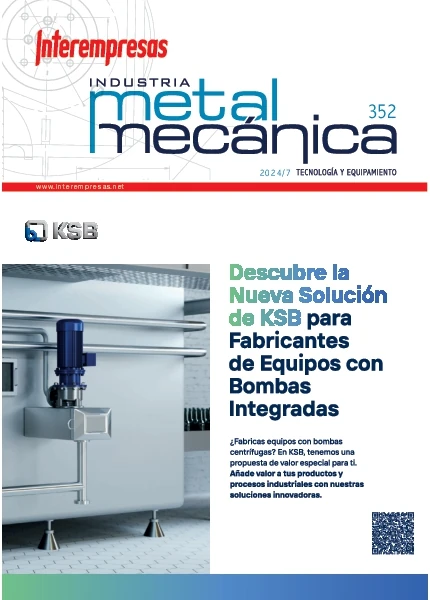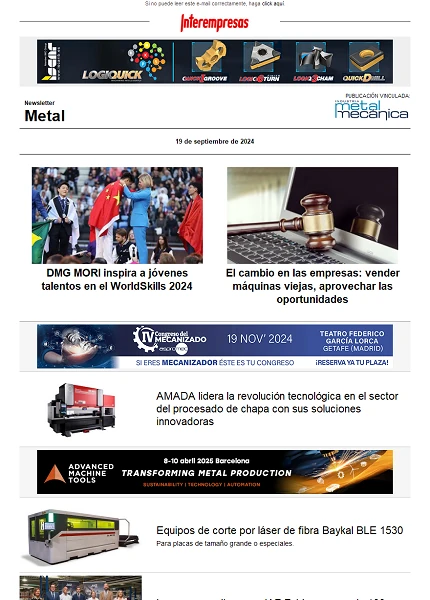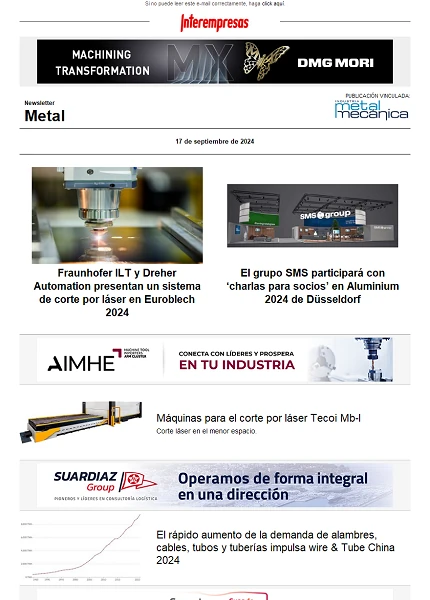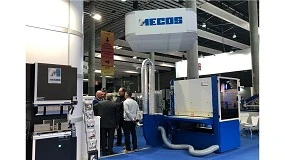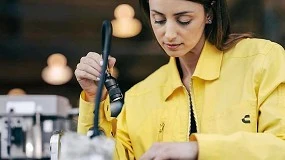The mechanised of the aluminium
However the high quantity of necessary power for his obtaining hampers his greater utilisation. But his recycled is of low cost, has an useful life dilated and stability of price. His density is 1/3 of the one of the steel, or the copper. Very malleable and ductile, apt for the mechanised and the smelting. His use exceeds to the of any another, excepting the steel. Because of his high heat of oxidation forms quickly to the air a fine superficial layer of oxide of aluminium (Alumina To the2Or3), waterproof and adherente, that detains the process of oxidation. The alumina gives him resistance to the corrosion and durability. This protective layer can be expanded by electrólisis in presence of oxalatos. Like the To the has characteristic anfóteras, dissolves so much in acids (salts of aluminium) like strong bases, forming aluminatos with the anion (To the(OH)4), and frees hydrogen. The To the reacts with ease with the HCl, NaOH, sour perclórico, but in general resists to the corrosion because of his oxide. However, when there are ions Cu++ and Cl- his passivation disappears, and is very reactive. The Alquilaluminios are so reactive that destroy the human fabric, and burn to the air. The oxide of To the is so stable, that uses to obtain other metals, from his oxides.
The main, and almost only state of oxidation is +III, as it is to expect by his 3 electrons in the layer of valency.
The pure aluminium is soft (Scale of Mohs 2-3) and fragile, but presents a clear grey tone, because of his protective coating. It melts to 660 °C. His alloys with small quantities of copper, manganese, silicon, magnesium, and other elements (Duroaluminio), present a big variety of suitable characteristics to a lot of applications. Good relation: resistance/weigh, concerning other metals.
In the history do not see to the aluminium, in spite of being so abundant in the planet, his industrial applications are relatively recent, from finals of the 19th century. In the antiquity used the alum, sulphate of To the and potassium. In 1825 the Danish physicist H.Oersted Achieved to isolate it for the first time, by electrólisis. The first syntheses of the metal obtained when reducing the chloride of aluminium with potassium. In 1835 substituyeron the potassium (expensive) with the sodium. The bauxite is a rich mineral in To the, between a 20-30% of the mass. The process Bayer is used for his two-phase extraction equipment equipment. First of the bauxite obtains the alumina, and of this separates the To the by electrólisis. Each tonne of To the requires 17-20 MWh of electrical power. Of the tubs of electrólisis happens to the oven where is purificado by means of the addition of a fundente, or alea with other metals, so as to obtain material with specific properties.
From 1960 the recovery of the aluminium from the scrap is easy. It costs only 5% of the necessary electrical power to extract it of the rock.
The To the has an atomic weight of 26.9815, and 9 isotopes whose atomic masses vary from 23 until 30. So only the isotope 27 is stable, with 14 neutrons. The isotope 26 has a period of disintegration of 720.000 years. The isotopes of aluminium use for dating of marine sediments and polar ices. In architecture the aluminium in the façade demands less material, and requires a structure bear lighter. A big saving in costs of construction and his use does not leave to grow.

Characteristics
This metal possesses a combination of properties, that do it very useful in engineering of materials, such as his low density (2.700 kg/m3), and his high resistance to the atmospheric corrosion. To diminish his density manufactures the To the alveolar, spongy, with several classes of alveolos. His limit of resistance to traction is of 160-200 MPa in pure state, but aleado can reach until 1.400-6.000 MPa. His elastic module is 70 GPa. The duroaluminio is an especially resistant alloy. The To the does not serve like structural element, but yes in shape of alloys.
Ductile, allows the manufacture of cables for electricity. It is good driver of the electricity (34-38 m/ohm/mm2) and of the heat. It mechanises with ease, and is relatively cheap.
Rubí – Sapphire
The alumina (To the2Or3) presents of amorphous or crystalline form. Amorphous is the superficial layer that recubre the To the. Crystalline hexagonal is the corindón: very hard (1.500-1.650 kgf/ mm2), excellent for pulir metals, and high melting-point (2.072 °C). In jewellery call it Rubí, if it is of red colour, and Sapphire, if it is of blue colour. The rubí-sapphire employs in the laser to produce the investment of the population.
On 16 May 1960 Theodore Maiman attained the first laser with a wand of rubí. Around the wand rolled up a lamp espiral of flash neon. It produced a download of light in the lamp of flash, that aroused the atoms of the wand of rubí to an upper energetic level, producing a phenomenon known like the investment of the population, in which there is a greater quantity of electrons in the upper layer And2 of the rubí, that the electrons that has the inferior layer And1. The electrons of the And2 jump downwards, to the And1, while they issue photons laser. These photons are in phase, and are of the same frequency.
Anodizado – Lacado
The To the after extruido or decapado form by himself only a thin film of oxide To the2Or3, of a thickness of only 0,01 micras on the surface, that confers him some minimum properties of anticorrosión. For engrosar this minimum layer exists the electrolytic process called anodizado, that gives excellent resistance to the chemical agents, greater hardness, low electrical conductivity and porous molecular structure, more durable that the painting. The anodizado gives to the To the a decorative appearance in several colours, with technicians of colouring so much organic like inorganic. The anodizado is not affected by the solar light, does not deteriorate .
The anodizado hard allows to obtain layers until 150 micras, according to the process and the alloy. The hardness of these layers is comparable to the one of the hard chromium, resistant to the abrasion, upper to a lot of steels, and to the frotamiento. The alumina is an electrical insulator, upper to the china.
To the process of painting call lacado: it is the application of a revestimiento organic. When it applies to the profiles of To the, consists in the application with electrostatic gun of a painting in dust, generally of type polyester. The lacado improves the aesthetic appearance and the physical properties of the To the. The thickness of the lacado is of 60-70 micras. The polimerizado realises in an oven.
The corrosion of the To the occur, if there is sour, particularly the perclórico and clorhídrico. In solutions very alcaline of KOH or NaOH occurs a forceful reaction. The presence of CuCl2, or CuBr2 is fatal for the To the, and dissolves in water. It reacts vigorously with Bromine in frio, and in hot with a lot of substances, reactions that go accompanied of broadcast of light. The corrosion affects more to the alloys of To the, that to the To the pure.
Extrusion - Smelting
The mass of To the semifluido, plastic, malleable, to 400-500 °C, does happen to pressesure by an abertura, mould, especially had to achieve profiles of design complicated in metal carpentry. To continuation follows the temper of the To the, cool it with air or water. To obtain profiles of To the recta, pulls them . There are several classes of temper, to increase the resistance of the To the. The To the recycled also can extruir.
The smelting of pieces consists in filling a mould with the quantity of metal melted, required by the dimensions of the piece, insert the colada in the mould. After the solidification the piece has the size and form of the mould. The piece can be a dental prosthesis, with weight of grams, or a big frame of machine, of several tonnes. It treats of complex forms, that can not attain with forge or laminación.
A light signpost and indeformable
The compound signpost Alucobond composes of two plates of aluminium, with 0,5 mm of thickness and a central core of polietileno macizo having a final thickness of 3,4 and 6 mm. Alucobond Guarantees an optimum amortiguación of vibrations. It is repelente to the dust, resistant to the intemperie and to a big quantity of finishings. It is recubierto with two layers of resins PFDF Fluoride of polivinilideno, applied with rollers electroestáticos, that ensure the continuity of colour, quality and durability, with a minimum of 10 years of guarantee. The resin is a thermoplastic semicristalino convertible by fusion. His molecular structure and his high cristalinidad give him big rigidity, high resistance to the break. Excellent resistance to the chemical products. His density is not problem: 1,7 g/cm3. It is possible to build panels of big dimensions, allows the milling, bent, cut and hit.
The panels of aluminium allow to create an architecture, compatible with the requests of functionality, aesthetic appeal and of design, excellent for enclosures and finishings. The carpentry of aluminium is ideal in the construction of covers, roofs, and even inner decoration, big elasticity of use.
Alloys
The To THE pure is a soft material and little resistant to the traction. To improve his mechanical properties it aleamos with copper, magnesium, manganese, cinc, silicon, etc. The popular duroaluminio owe it to the German metallurgist Alfred Wilm, that it aleó with the copper (only 3-5%). At present the alloys of To the classify in series, from the 1.000 until the 8000. The duroaluminio (To the2Cu) belongs to the series 2000, with a resistance to the traction of 442 MPa, apt for the aeronautical sector component manufacturing sector component manufacturing. They exist alloys of forge and of smelting, with different properties. We quote besides the Superaleaciones, that consist in 3 or more elements, designed to reach high temperatures, of high price. They use in álabes of turbine of gas.
To save weight it is necessary to diminish the density. In the To the the solution has consisted in the To the alveolar. By ej.: Alucore Is a signpost of To the compound, with two layers of cover and a core of alveolar type of To the. The pores or alvéolos can be hexagonal or no.
The To the form composed no metallic, that are not alloys: already we have mentioned the Alumina. There is besides the aluminosilicatos, an important class of minerals, form part of the clays, and are the base of a lot of ceramics and glass. The hydroxide of To the employs like antiácido and in treatment of waters.
Mechanised – cutting
The machine-tool of start of shaving obtains the mechanised fast. For the start of shaving the strengths of cut are lower that for the steel. The necessary strength is 30% of the used to mechanise the steel. The machine tool is of Numerical Control, with cabezales powerful and robust, that allow to turn to thousands of revolutions by minute, until 30.000 rpm. The thermal sensors conductivity of the To the is elevated, and allows that the heat generated in the mechanised dissipate with rapidity. The mechanised fast allows that a lot of complex pieces was not necessary to melt them, but demands a costly investment in machinery. The cut of sheets does with cutting cutting shears.
When it is necessary to do dobleces is important to consider the steering of the grain. The composition in the metal, when manufacturing it, has taken a steeringal tendency in his microstructure, showing like this a greater length to a steering that to another. As how this doblez can break the leaf of To the.
There are 3 families of tools of cut for the mechanised of the To the:
- fast Steel, for alloys of To the with low content of Silicon. It allows the use of big angles of desprendimiento, to obtain some better conditions of cutting. There are tools of fast steel pulvimetalúrgico recubierto. For the superficial finishing there is plaquitas, that satisfy even exigencias very high. Microdureza Of the layer HV 2500.
- Hard metal (metallic carbides, widia) and Diamante. These tools last more. For the mechanised of To the with big content of Silicon do lacking tools of metallic carbide. They employ in the mechanised of To the to high speeds of cutting. The foundries of To the with the presence of glasses of Silicon is of high hardness. There is tool of hard metal of grain ultra fine. Hardness HV 1850. 6% of content of cobalt.
- The Diamond has high length, and is very useful for the mechanised of pieces that generate a lot of shaving. Hardness HV 10.000.
- A mechanised special is the repujado. A technician of craftsmanship, that consists in working a block of To the, to obtain an ornamental drawing in relief. Like tool uses a buril fine.
The taladro
There is the broca for metal, of the suitable diameter, lubricated with oil of cut, taladro vertical of column and the taladro electronic, for low speed. To continuation the saw of calar and hand-held saw. The punzón, or a good nail, and the hammer serve to mark. Avoid so the broca displace of the point.
Spark-erosion
Also call it Mechanised by electrical download. We remember that the To the is conductive of the electricity. Spark-erosion is the generation of an electrical arch between the metallic piece and an electrode, in a half dielectric, to start shavings of the piece, until achieving reproduce in the To the the forms of the electrode. Both, piece and electrode have to be conductive, to initiate the arch that starts shavings of metal. It serves to mechanise complex forms.
There are two versions: the known as RAM, ariete, and is illustrative of the crash of the electrode against the piece. The another version uses the electrode of metallic thread.
During the spark-erosion the piece and the electrode are almost together, a distance of hundredth of millimetre. When applying a difference of tension contínua, pulsante, creates an intense electrical field, that causes an increase of temperature until 20.000 °C, jumps the spark, and volatiliza part of the metal. Depending on the machine, the process repeats thousands of times by second. It is possible to change the polarity between the electrode and the metal. The piece suffers a uniform erosion, that reproduces the form of the electrode. The taxles of start of shaving with electrode of form are in the order of 2 cm3/h.
The electrode of form is of graphite, with his high temperature of vaporisation. It can be worked with a fresadora, with the end to create a male electrode or female. This means that the electrode will have the opposite form to the form wished and resultant in the piece of work. The electrode also can be of copper, but his wear is faster.
The electrode of form allows to cut fragile materials, and can produce holes very bent in surfaces curves, without problems of slide. As well as a high relation of appearance (quotient between the length and the diameter) that is to say, with small diameter and big depth, impossible in a taladro conventional. With tolerances very adjusted, in hundredth of mm. By ej.: Pierced of the filters of the injectors in the industry of the car.
The spark-erosion by thread: it Is more modern that the previous process. The taxles of start of material with thread rondan the 350 cm3/h. The thread can be of brass or of cinc, of a diameter of tenth of mm. The break of the thread does not create problems.
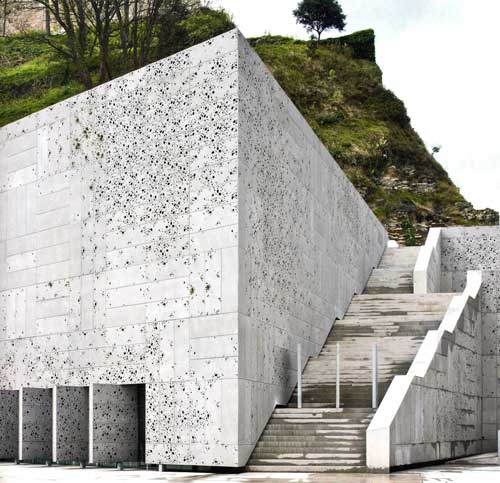
Welding
The soldeo of To the is to the arch in inert atmosphere (argon, helium) by points, or by friction, current contínua or alternating. There are two technicians of welding to the arch: under inert atmosphere with refractory electrode, or procedure TIG, and the welding in inert atmosphere with consumables electrode MIG (Metal Inert gas).
The TIG (Tungsten Inert gas) has electrode of tungsten, permanent, does not wear out. TIG Is very used for To the, uses alternating current stabilised. The thickness of the ironinging can be until of 6 mm. Besides it is possible the welding robotizada. The gas argon protects the bathroom of fusion against the oxidation.
MIG Uses electrode consumables thread for the tool of welding, the gun, with gas argon. It uses common contínua, with the negative pole in the piece and the positive in the electrode-thread. The current is intense: 250-300 To.
Moldeo
To obtain a piece of To the melts this, and pours in the mould for the forming by moldeo. 5.000 years ago already it used the moldeo, smelting or colada. First it is necessary to design the piece in wood or plaster, of form artesanal. Afterwards it builds the mould, that will be of sand. If the piece is hollow, it is necessary to build male. The filled of the mould knows like colada. The To the cools in the mould. The desmoldeo consists in extracting the already solidified piece. It exists the moldeo of the To the in state semisólido, because it combines the advantages of the smelting and forges it. They attain pieces of smelting of high quality: blocks of engine, filters of pumps of oil, etc. The thermal sensors distortions and the contractions of solidification are inferior.
Recycling
The To the is 100% recyclable, without merma of his properties. It is necessary to melt the To the, and for this does fault only 5% of the necessary power to produce it. Recycle tins of drink, these have the highest value of all the waste, which is an incentive for his recovery. In 2002 they produced in Spain 243.000 tonnes of To the recycled. This scrap compact, and carries to the oven of smelting.
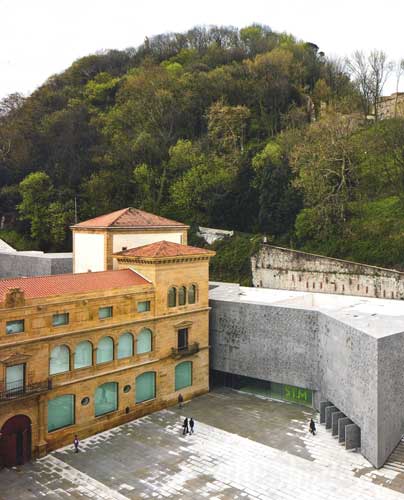
The future of the aluminium
From the years 1950 the polymeric compounds reinforced with fibres of carbon have showed a relation Resistance/weigh upper to a lot of metals. The new aeroplanes, by ej.: Boeing 787 has only 20% of aluminium (year 2009). Instead the old Boeing 777 (year 1995) has 50%. The To the has a low density, but is soft. The To the of grain very fine is more resistant, but is less ductile. In low atmospheric temperatures: high atmosphere and stratosphere the To the goes back brittle. A problem in aeronautical sector component manufacturing sector component manufacturing.
Nevertheless need the To the for a lot of applications, even for long tended of electrical lines: for being less dense that the copper, the towers of high tension can space more. In the industry the To the keep on being very important, and do not refer me to the boats of drink. His properties are very different to the ones of the fibres of carbon, but the future of the To the is firmly ensured.
References
- 787 Dreamliner Program Fact Sheet. Boeing Corp. 2007.
- M.F.Ashby. Materials selection in Mechanical Design. Elsevier, Oxford. 2005.
- M.To.Meyers, To.Mishra, D.Benson. Prog.Mater.Sci 51 – 427. 2006.
- And.Kimura, T.Inoue, F.Vin, K.Zuzaiki. Science, 320, 105.2008.
- L.lu, And.Shen, X.Chen, L.Quian, Science, 304, 422, 2004.
- To.King, G.Johnson, D.Engelberg, Science, 321, 382, 2008.
Notices:
The photos of these pages are of the Museum of Saint Telmo, San Sebastián, designed and built by Grandson Sobejano, architects. Biennial prize Iberoamericana of architecture. Finished in 2011. The walls are recubiertas by ironingings of aluminium drilled artistically. The ancient building also belongs to the Museum, is an ancient convent of friars dominicos, built around the middle of the 16th century, in the skirt of the mountain Urgull.




